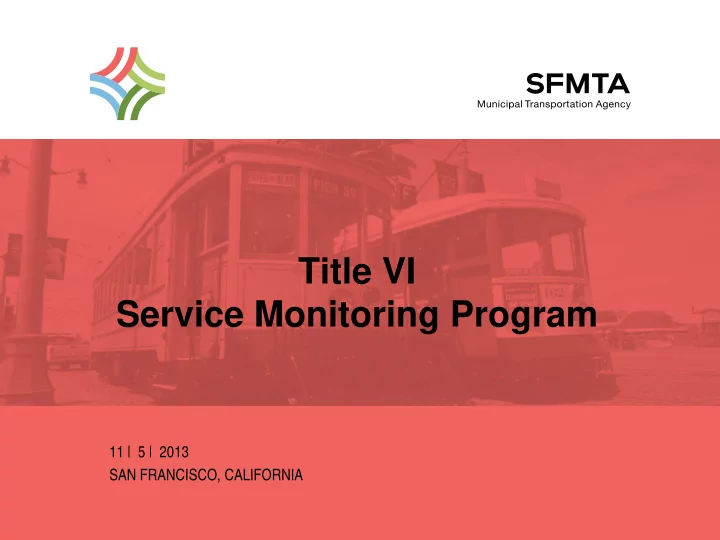

SFMTA Municipal Transportation Agency Image: Historic Car number 1 and 162 on Embarcadero Title VI Service Monitoring Program 11 | 5 | 2013 SAN FRANCISCO, CALIFORNIA
Title VI Overview • Title VI of the Civil Rights Act of 1964 addressed discrimination in most areas of public life in the U.S. • Title VI states: – “No person in the United States shall, on the ground of race, color, or national origin, be excluded from participation in, be denied the benefits of, or be subjected to discrimination under any program or activity receiving federal financial assistance.” • Federal Transit Administration (FTA) – Monitors transit providers for Title VI compliance; updated circular issued October 1, 2012 (FTA C 402.1B) provides guidance for transit agencies receiving federal funds 2
Monitoring Program • As part of Title VI program requirements, SFMTA is required to monitor performance of minority routes compared to non-minority routes compared to service standards • Required to perform service monitoring at least every three years; SFMTA will perform annually as a best practice • Performed on all routes • Required to monitor from a random sample: – On-Time Performance – Headways – Passenger loads – Coverage – Amenities – Fleet Assignment 3
How Does the SFMTA Define… • Minority Population – Census block group with minority residents at or above the Citywide average of 58% • On-board passenger survey underway to supplement geographic information (will not be available for 2013 Title VI program update) 4
Non-minority Block Group Minority Block Group 5
On-Time Performance • Standard: Proposition E on-time performance standard is 85% • Performance: No minority or non-minority lines met the standard and no disparate impact found • Minority routes out performed non-minority routes in radial bus and crosstown route types Route Type Minority Route Average Non-Minority Route Average Radial Rail 42% 46% Radial Bus 62% 60% Crosstown 63% 61% Feeder/Comm unity 64% 68% Radial Express 71% 73% 6
Vehicle Headways • Service standards for headways (route frequency): Weekday Weekend Route Type Peak Base Evening Owl Base Evening Owl Radial 10 15 20 30 15 20 30 Cross-town 15 15 20 30 20 30 30 Feeder/Community 20 30 30 -- 30 30 -- Express 10 -- -- -- -- -- -- • Performance: Minority lines met the service standard more often than non-minority lines in all categories except for “crosstown”. Disparate impact found on “crosstown” routes. Non-Minority Route Route Type Minority Route Average Average Radial Rail 100% 100% Radial Bus 74% 63% Crosstown 63% 97% Feeder/Community 94% 88% Radial Express 81% 80% 7
Vehicle Loads • Standard: No more than 4% of peak period trips experiencing a load factor of 125% during the morning and evening peak • Performance: All below standard except for non-minority radial rail routes. Minority routes performed better or similarly to non-minority routes. No disparate impact found. AM Peak (6-9AM) PM Peak (4-7PM) Route Type Minority Non-Minority Minority Non-Minority Radial Rail 0.00% 5.7% 0.0% 9.6% Radial Bus 0.04% 0.2% 0.3% 0.4% Crosstown 0.6% 0.2% 0.36% 0.28% Feeder/Community 0.1% 0.2% 0.0% 0.0% Radial Express 0.1% 0.0% 0.0% 0.0% 8
Service Availability • All residential areas are within a quarter mile of a bus stop • Areas further than a quarter mile are located in the Presidio, Lake Merced, Hunter’s Point Shipyard, and Candlestick Point 9
Transit Amenities • Standards: – All stops have a stop ID and are marked – Stops with more than 125 daily boardings have a shelter within environmental constraints – Powered and sheltered stops should get real-time arrival displays • Performance: Disparate impact found. Non-minority stops were more likely to have shelters and real time displays. We are prioritizing shelter installations in minority areas. Seven of the last nine new shelters have been in minority areas. Stops with 125 Percent with or More Percent with Real-Time Boardings Shelters Displays Stops in Minority Census Block Groups 480 58% 41% Stops in Non-Minority Census Block Groups 597 66% 48% 10
Vehicle Assignment • Vehicles assigned to divisions based on maintenance capabilities and capacity • Assigned to routes randomly based on division • Performance: No disparate impact. Newest buses at divisions with highest proportion of minority routes. Percentage of Lines that are Minority at Division Mode Average Age (Years) Division Green Light Rail 18 17% Metro East Light Rail 18 17% Flynn Articulated Motor Coach 11 71% Kirkland Forty Foot Motor Coach 12 13% Thirty and Forty Foot Motor Woods Coach 8 62% Forty Foot and Articulated Trolley Potrero Coach 11 14% Presidio Forty Foot Trolley Coach 13 14% Geneva Historic Streetcar Varies - Historic 0% Cable Car Cable Car Varies - Historic 67% 11
Next Steps • Met with the Citizens Advisory Committee on October 3rd • Present to the SFMTA Board of Directors – November 5th • Submit to FTA by December 1st 12
Recommend
More recommend